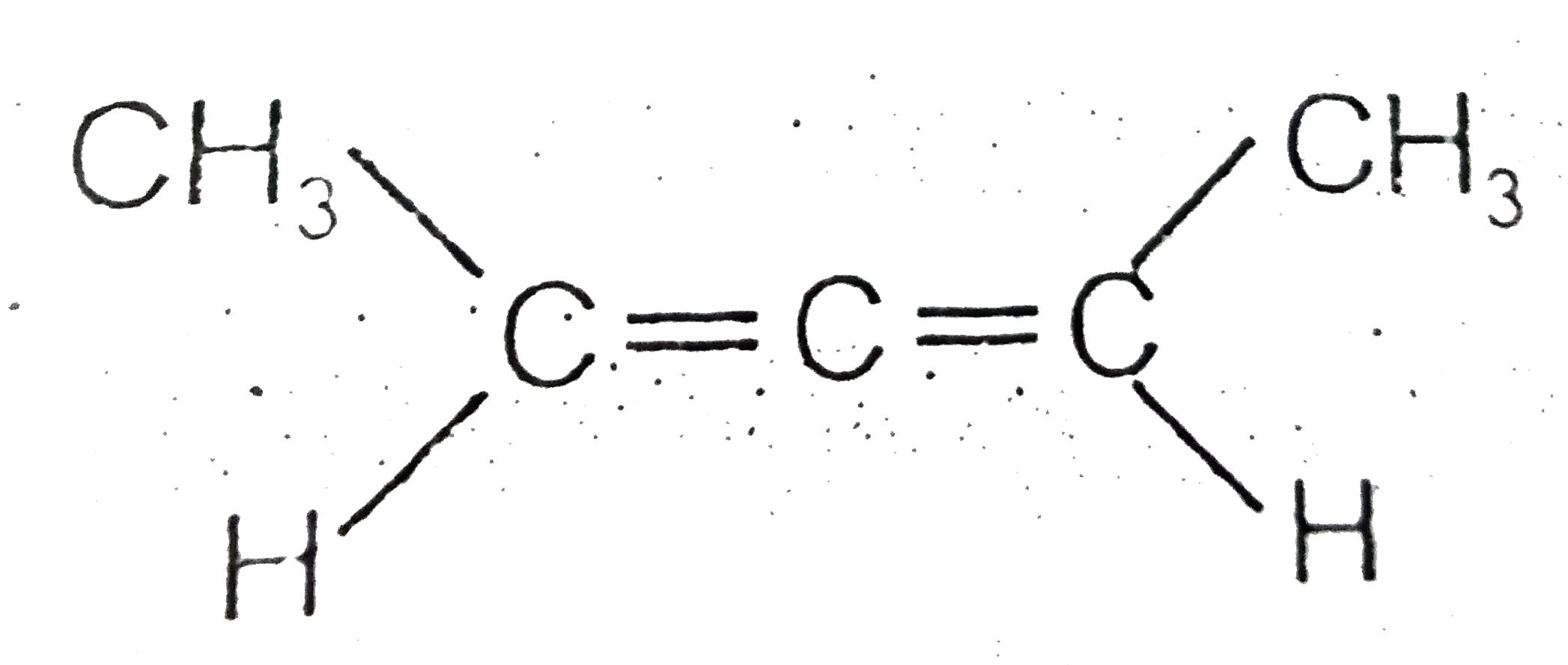Which of the following cannot be resolved into enantiomers ?
(a) 
(b) 
(c) 
(d) 
The correct Answer is:(2,3)
To solve the question of which of the following compounds cannot be resolved into enantiomers, we need to analyze each option based on their structural characteristics and optical activity. Enantiomers are non-superimposable mirror images of each other, and for a compound to be resolved into enantiomers, it must be optically active.
1. Understanding Enantiomers:
- Enantiomers are optically active compounds that are non-superimposable mirror images of each other. A compound can only be resolved into enantiomers if it lacks a plane of symmetry and is chiral.
2. Analyzing Option A (Allene):
- An allene can be optically active if it has an even number of double bonds and the substituents on the double bonds are different. In this case, since the allene has two double bonds and the groups attached are not identical, it can be optically active. Therefore, it can be resolved into enantiomers.
3. Analyzing Option B (Biphenyl):
- For biphenyl compounds to be optically active, they must have bulky groups at the ortho positions. In this case, if the biphenyl only has hydrogen and deuterium, it will have a plane of symmetry. Since it is optically inactive, it cannot be resolved into enantiomers.
4. Analyzing Option C (Nitrogen Compound):
- The nitrogen compound has three different groups attached to the nitrogen atom. However, due to the presence of a lone pair, it can undergo pyramidal inversion, leading to the formation of a racemic mixture. This means it is optically inactive and cannot be resolved into enantiomers.
5. Analyzing Option D (Chiral Carbon):
- In this case, the carbon is substituted with four different groups, making it chiral. A chiral compound is always optically active, and thus it can be resolved into enantiomers.
6. Conclusion:
- Based on the analysis:
- Option A: Can be resolved into enantiomers (optically active).
- Option B: Cannot be resolved into enantiomers (optically inactive).
- Option C: Cannot be resolved into enantiomers (optically inactive).
- Option D: Can be resolved into enantiomers (optically active).
- Therefore, the correct options that cannot be resolved into enantiomers are B and C.
Final Answer:
The compounds that cannot be resolved into enantiomers are B and C.
- Enantiomers are optically active compounds that are non-superimposable mirror images of each other. A compound can only be resolved into enantiomers if it lacks a plane of symmetry and is chiral.
- An allene can be optically active if it has an even number of double bonds and the substituents on the double bonds are different. In this case, since the allene has two double bonds and the groups attached are not identical, it can be optically active. Therefore, it can be resolved into enantiomers.
- For biphenyl compounds to be optically active, they must have bulky groups at the ortho positions. In this case, if the biphenyl only has hydrogen and deuterium, it will have a plane of symmetry. Since it is optically inactive, it cannot be resolved into enantiomers.
- The nitrogen compound has three different groups attached to the nitrogen atom. However, due to the presence of a lone pair, it can undergo pyramidal inversion, leading to the formation of a racemic mixture. This means it is optically inactive and cannot be resolved into enantiomers.
- In this case, the carbon is substituted with four different groups, making it chiral. A chiral compound is always optically active, and thus it can be resolved into enantiomers.
- Based on the analysis:
- Option A: Can be resolved into enantiomers (optically active).
- Option B: Cannot be resolved into enantiomers (optically inactive).
- Option C: Cannot be resolved into enantiomers (optically inactive).
- Option D: Can be resolved into enantiomers (optically active).
- Therefore, the correct options that cannot be resolved into enantiomers are B and C.
The compounds that cannot be resolved into enantiomers are B and C.
Topper's Solved these Questions
- HALOALKANES AND HALOARENES Book:AAKASH INSTITUTE ENGLISHChapter:HALOALKANES AND HALOARENES Exercise:Assignment (Section - D) (Linked Comprehension Type Question )
Explore 8 Videos
- HALOALKANES AND HALOARENES Book:AAKASH INSTITUTE ENGLISHChapter:HALOALKANES AND HALOARENES Exercise:Assignment (Section - E) ( Assertion - Reason type Questions )
Explore 7 Videos
- HALOALKANES AND HALOARENES Book:AAKASH INSTITUTE ENGLISHChapter:HALOALKANES AND HALOARENES Exercise:Assignment (Section - B ) ( Objective Type Question(One option is correct ))
Explore 36 Videos
- GENERAL PRINCIPLES AND PROCESSES OF ISOLATION OF ELEMENTSBook:AAKASH INSTITUTE ENGLISHChapter:GENERAL PRINCIPLES AND PROCESSES OF ISOLATION OF ELEMENTSExercise:Try Yourself
Explore 33 Videos
- HYDROCARBONSBook:AAKASH INSTITUTE ENGLISHChapter:HYDROCARBONSExercise:Assignment(Section - C) (Previous Years Questions)
Explore 60 Videos
Similar Questions
Which of the following compound can be resolved into enatiomers ?
View SolutionWhich of the following cannot be hydrolysed ?
View SolutionWhich of the following cannot be hydrolysed?
View SolutionWhich of the following cannot be a base?
View SolutionWhich of the following molecule can resolved into enantiomers ?
View SolutionWhich of the following cannot be polarised?
View SolutionWhich of the following cannot he formed ?
View SolutionWhich of the following are not resolvable?
View SolutionWhich of the following cannot be acylated ?
View SolutionWhich of the following cannot fix nitrogen?
View Solution
